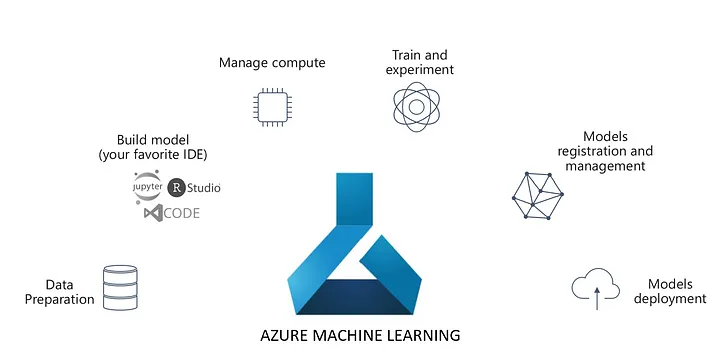Understanding Azure Machine Learning
Azure ML is a comprehensive service supporting the entire ML lifecycle, from data ingestion to model deployment and monitoring. It integrates seamlessly with other Azure services, such as Azure Synapse Analytics, Azure Data Lake, and Azure Cognitive Services, making it ideal for enterprise-grade AI solutions.
Key Components of Azure Machine Learning
Azure ML Workspaces: Centralized environments for managing ML assets like datasets, models, and pipelines.
-Compute Resources: Scalable virtual machines and GPU-enabled clusters for model training.
-Azure ML Pipelines: Tools to orchestrate end-to-end ML workflows, improving reproducibility and automation.
-Model Registry: Central repository for storing and managing model versions.
Steps to Build Scalable AI Models with Azure ML
Step 1: Data Collection and Preparation
Data preparation is foundational for scalable models. Use Azure Data Factory to integrate and clean data from multiple sources and store it in Azure Data Lake. Leverage Azure ML Datasets for versioned data management, ensuring consistency across experiments.
Step 2: Model Development and Training
Develop models using Jupyter notebooks integrated with Azure ML. Use AutoML for automated model selection and hyperparameter tuning. For large datasets, distribute training across multiple nodes using Azure ML Compute Clusters, which support GPUs for accelerated training.
Step 3: Model Deployment at Scale
Deploy models using Azure Kubernetes Service (AKS) for real-time inference and autoscaling. For testing and lightweight deployments, utilize Azure Container Instances (ACI). Manage endpoints and version deployments with Azure ML Endpoints.
Step 4: Model Monitoring and Maintenance
Implement continuous monitoring using Azure Monitor and Application Insights. Set up alerting for model performance drifts and automate model retraining workflows with Azure ML Pipelines.
Best Practices for Scalable AI Models
-Build Modular Pipelines: Segment ML workflows into reusable components for consistent scaling.
-Optimize Compute Resources: Use GPU-enabled clusters for deep learning models.
-Implement CI/CD: Integrate Azure DevOps for automated deployments and rollback mechanisms.
-Ensure Model Explainability: Use Azure ML's interpretability toolkit to assess feature importance.
-Promote Responsible AI: Implement fairness and transparency principles using Azure Responsible AI tools.
Case Study: Retail Demand Forecasting with Azure ML
A global retailer used Azure ML to forecast demand, reducing stockouts by 25%. They implemented AutoML for model selection and deployed the final model on AKS. Azure ML Pipelines automated their retraining workflows, ensuring models stayed accurate with changing trends.
Future Trends and Innovations in Azure ML
Emerging trends in Azure ML include:
- AI Agents: Autonomous models that interact with other systems to solve complex tasks.
- Federated Learning: Collaborative model training without sharing sensitive data.
- Low-Code Model Development: Enhanced visual tools for rapid AI prototyping.
Conclusion
Azure Machine Learning empowers organizations to build and deploy scalable, production-ready AI models efficiently. By utilizing AutoML, distributed training, and ML pipelines, businesses can accelerate their AI journey. Integrating Azure services ensures scalability, security, and performance, driving impactful business outcomes.

